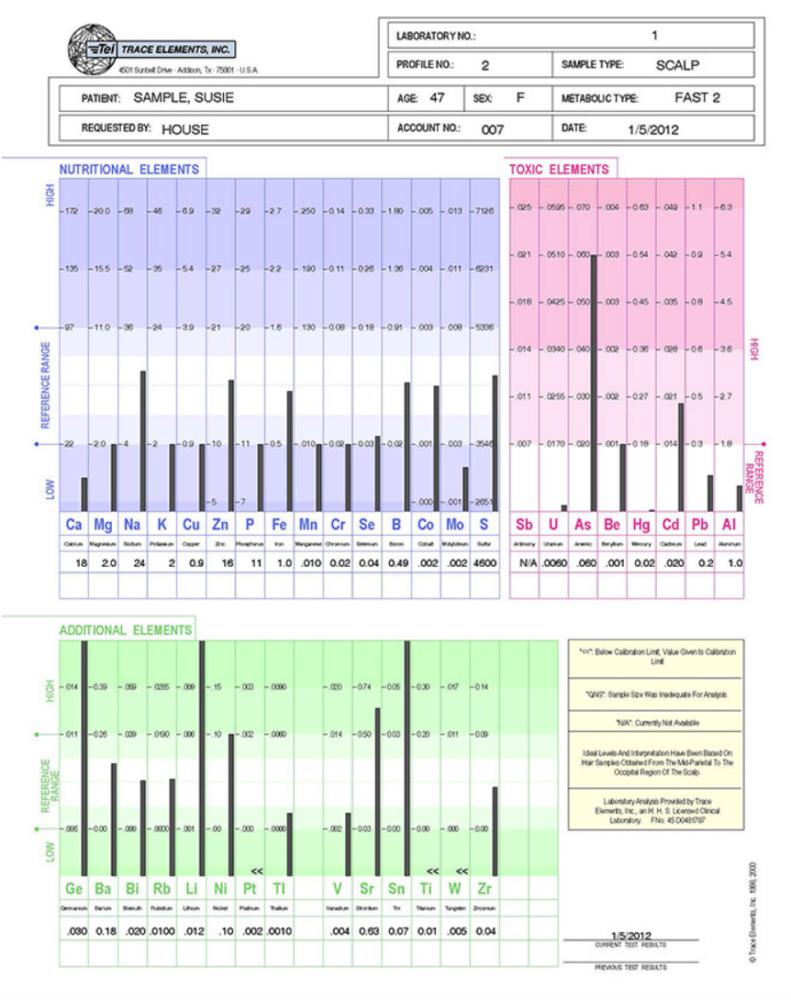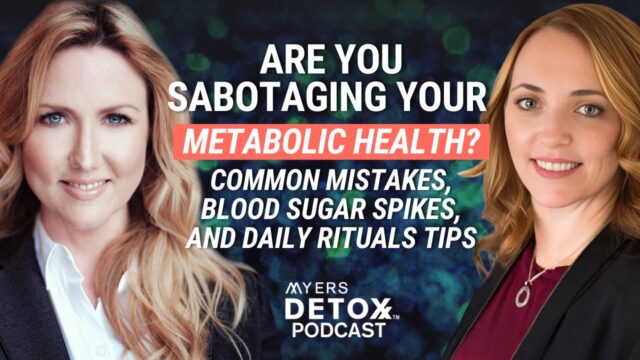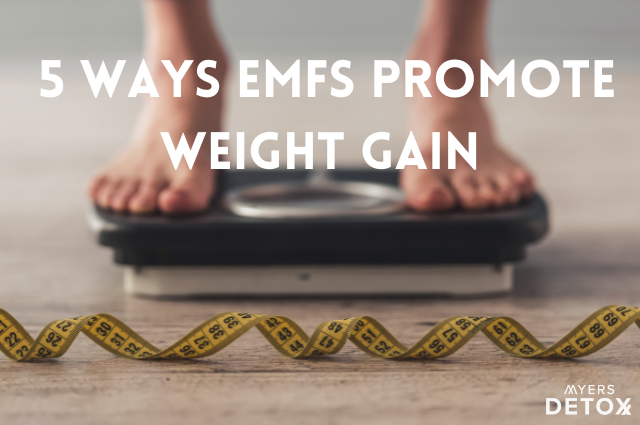What you will learn
- This article is your definitive guide to HTMA. It will cover how HTMA works, what you can learn from it, how reliable it is, and how you can benefit from getting hair mineral analysis done.
- The pros and cons of Hair Mineral Analysis, Urine, Stool and Blood Heavy Metals Testing
- If you have brain fog, fatigue, mood swings, or other symptoms that your doctor can’t seem to help with, there’s a good chance toxins are the culprit. An HTMA can help determine what metals are the source of your health issues.
- The mineral levels in your hair can give you insight into your metabolism, cellular health, toxic heavy metal load, energy production, mineral deficiencies, mineral imbalances, nutritional status, and a variety of common health conditions.
We live in an increasingly toxic world. Air pollution, smog, pesticides, tap water, environmental pollution, product additives – there are more sources of toxins around you than you may realize.
Toxins, especially heavy metals, are one of the most common (and overlooked) causes of unexplained health issues. If you have brain fog, fatigue, mood swings, or other symptoms that your doctor can’t seem to help with, there’s a good chance toxins are the culprit.
The good news is that there’s a simple, affordable way to test for heavy metals and other toxins: hair mineral analysis (HTMA).
HTMA is an affordable, noninvasive lab test that measures the mineral content of your hair. Your hair contains a great deal of information about your biology.
The mineral levels in your hair can give you insight into your metabolism, cellular health, toxic heavy metal load, energy production, mineral deficiencies, mineral imbalances, nutritional status, and a variety of common health conditions.
Hair mineral analysis is one of the best (and easiest) ways to improve your performance and feel better every day. Minerals are like the “spark plugs” of your biology — they drive reactions and biological pathways in almost every process in your body.
Hair mineral analysis is painless and easy to do – you just have to take a small hair sample and send it into an accredited hair analysis lab. With the test results from an HTMA, you can learn about everything from heavy metals that are slowing you down to mineral ratios you can balance for optimal brain function and more energy.
This article is your definitive guide to HTMA. It will cover what HTMA is, how it works, what you can learn from hair testing, the reliability of HTMA, and how you will benefit from getting hair mineral analysis.
What is HTMA?
HTMA is an hair mineral analysis test that measures minerals and heavy metal levels using a small sample of hair.
Your hair contains more information about your biochemistry than you might think. Trace minerals, heavy metals, and a variety of other compounds get excreted through your hair, which makes hair analysis an ideal way to get a big picture look at how your body is running, as well as more targeted insight into various aspects of your biology.
There is a very strong correlation between the levels of minerals and heavy metals in the tissues of your body and what is excreted into the hair. This is what makes it ideal for looking at your body burden of heavy metals.
Getting a hair analysis test is simple. You order an HTMA test kit online, cut a sample of your hair, and mail it to a lab. After a couple weeks, you’ll get a full report on the mineral and heavy metal content of your hair and what that means for you. There’s no need for a blood test or a visit to a clinic – you can get an HTMA without leaving your home.
What Can You Learn From an HTMA?
Once you have your HTMA test results, you can start learning about what’s going on in your body.
Here’s a sample of an HTMA report:
HTMA measures almost 40 different compounds in your hair. In the sample results above, you can see that HTMA provides a reference range. These are the ideal ranges for each mineral. You’ll also see low and high ranges. These reference ranges can tell you exactly which minerals, essential elements, and heavy metals are out of balance.
This information is the key to better health. Maybe you have low magnesium or zinc levels, which are incredibly important for heavy metal detox. In fact, magnesium is so important, it’s used in over 3700 processes in the body. Deficiency in this vital mineral can ruin your health.
Or maybe your test reveals high levels of heavy metals like mercury or arsenic. These heavy metals cause fatigue, brain fog, hair loss, and a variety of other health problems. It’s vital that you know which ones are an issue for you.
Heavy metal toxicity is especially important for your health. A 2007 research paper, for example, noted that “a study of men over a period of thirteen years found that for each microgram of mercury found in the hair, the risk of acute coronary events increased by an average of eleven percent and cardiovascular disease death rate by ten percent.”
If you have fatigue, brain fog, or other possible symptoms of heavy metal buildup, it’s essential for your wellbeing that you get an HTMA test sooner rather than later. Once you do, you can work with a healthcare professional or functional diagnostic nutritionist to start detoxification and reclaim your vitality.
HTMA vs Urine, Stool, and Blood Testing
It’s not that hair mineral analysis tests are better or worse than urine, blood or stool tests; each test has its pros and cons. The important thing to know is these tests give different information. Some metals excrete into the hair, some metals excrete into the urine, some into the stool.
I prefer HTMA as an initial screening tool for heavy metals because it is the easiest and cheapest to do and gives the most information about heavy metals, minerals and overall health status.
Ideally, because different heavy metals tests show different heavy metals, it good to do hair, urine and stool heavy metals tests to get the most complete picture of one’s body burden of heavy metals.
Here is a comparison, including pros and cons, of each heavy metals test:
HTMA- Hair Mineral Analysis
- Minerals show best on HTMA. Minerals are key to detox. One needs to check what minerals are low and replace these minerals because minerals displace heavy metals from the body and are the foundational key to all detox.
- Noninvasive and inexpensive.
- Shows many heavy metals you cannot see or rarely show on other heavy metals tests – uranium, aluminum,
- HTMA shows methylmercury from fish and seafood. Urine is where we detect inorganic mercury from mercury amalgam fillings.
- Some people genetically do not excrete heavy metals into the hair and thus get “false negatives”.
- Some people are too sick and their body does not have enough energy to detox. Thus, they do not excrete heavy metals into the hair on an initial test. This rule holds true for all heavy metals tests, including HTMA, urine, stool and blood. However, once they begin a detox program and supplementation, heavy metals begin to appear on subsequent tests.
- One must have hair to do an HTMA – or be willing to part with some hair. Scalp and beard hair is best as it’s most biologically active and fast growing. Underarm cannot be used as it’s typically contaminated with aluminum from deodorant. Pubic hair and chest hair should not be used.
Urine
- The most common metal toxicities seen in urine are thallium, cesium, mercury, nickel, lead and arsenic.
- Shows many metals that are not tested on an HTMA, which can be clues to one’s health issues.Many people have platinum, palladium, tungsten, beryllium and other uncommon metals toxicities that are the clue to their underlying health issues that could not be seen with HTMA alone.
- Urine is where we detect inorganic mercury from mercury amalgam fillings. HTMA shows methylmercury from fish and seafood.
- Does not show minerals accurately as it’s only a 6-24 hour test. Thus, mineral needs for supplementation or replacement cannot accurately be deduced from the urine.
- Urine testing can be done with and without oral chelating agents like DMSA, EDTA or DMPS – also known as a challenge test. If you use chelating agents, costs can be much higher because one must see a medical doctor to get a prescription for oral chelating agents and they are not available at any pharmacy (usually only out of state compounding pharmacies online have them available). Chelators are used because they remove more heavy metals than you would urine out on your own. However, you don’t need them to see your heavy metal levels as the body excretes most heavy metals on its own. But you will see more lead, mercury and nickel in the urine by taking chelating agents.
- Many people who are seriously ill, have multiple health conditions or have a sulphur sensitivity cannot tolerate synthetic sulphur chelating agents like DMSA, EDTA and DMPS and thus are not candidates to do urine challenge tests. This population can, however, do a urine test without chelating agents. Anyone can do an HTMA.
- Some people are too sick and their body does not have enough energy to detox. Thus, they do not excrete heavy metals into the urine on an initial test. This rule holds true for all heavy metals tests, including HTMA, urine, stool and blood. However, once they begin a detox program and supplementation, heavy metals begin to appear on subsequent tests.
Stool
- Stool is key to see silver toxicity from mercury amalgam fillings or abuse of colloidal silver supplementation. This can be important to know because silver kills good gut bacteria and can be key in revealing digestive issues.
- Stool is the best test to see cadmium (which rarely shows in urine and stool. This is important because cadmium causes more cancers than all the other heavy metals combined.
- Stool is also good to see lead levels which rarely shows on HTMA, but typically shows in urine (but only with a DMSA urine challenge)
- You can also test gold toxicity in stool, which one can have if they have gold fillings or crowns.
Blood
- The standard blood tests performed by medical doctors is not an accurate test for heavy metals. The body does not allow heavy metals to remain in the blood for very long because they can damage vital organs. Within a few weeks of ingestion or exposure to a metal, the body sequesters metals away into bone, fat and other tissues. Thus, blood almost always have false negative results where no metals show in the blood. Unless someone has had a very recent heavy metal exposure, blood testing is useless.
- Most blood tests are inadequate in that they only test for four metals – arsenic, mercury, cadmium and lead. There are dozens of heavy metals and one must do thorough testing to discover what is at the root of one’s health issues.
- The ONLY blood test that is accurate is Chris Shade’s Quicksilver Blood Metals Panel test. This test employs state-of-the-art inductively coupled plasma/mass spectroscopy, and thus is completely different than the simple blood test done by most medical doctors. It tests for 16 heavy metals, but will miss many heavy metals that can be detected with other methods.
- The simple blood test for heavy metals is the only test covered by medical insurance.
While blood and urine tests offer snapshots of your biology, HTMA provides a longer-term view of how your body is doing. Minerals and toxic heavy metals aggregate in your hair from all over your body, which means HTMA can give you big-picture information about your health. The tissue levels of metals and minerals in the body are very strongly correlated to the levels seen on an HTMA.
How to Interpret Hair Mineral Test Results
There’s also the matter of interpretation. You can get basic insights from interpreting results yourself — high mercury is a clear sign that you need to detox, for example.
However, there’s a deeper science to figuring out how to balance your mineral levels. For example, elevated boron (a mineral) could actually be a sign of a good diet, even though it’s outside the reference range. Low boron on its own could indicate an issue with hormone production. Low boron and low magnesium together suggest a nutritional deficiency that you can correct by eating more leafy greens.
These nuances are hard to spot without training. You can still get plenty of value from HTMA on your own. That said, you’ll get the most out of your test if you work with a trained practitioner to interpret your results.
Practitioners can give you deep insight into heavy metal toxicities not apparent on your HTMA, your nutritional status, metabolism, and more. Most importantly, they can help you develop a plan to fix any mineral imbalances and remove heavy metals from your body with a targeted plan for the specific heavy metal toxicities that you have.
Who Should Get Hair Mineral Analysis?
Should you get an HTMA?
It depends on your goals and the state of your health. If you have any of the following symptoms, there’s a good chance an HTMA will help you figure out how to address them:
- Fatigue
- Brain fog
- Joint or muscle pain
- Sudden weight gain
- Trouble with weight loss
- Poor memory
- Hormone imbalances
- Heavy periods
- Low sex drive
- Mood swings
An HTMA test can give you insight into the root causes of the above issues and provide you with information you need to guide you towards better health and wellness.
If you’ve ever looked into getting blood work done, getting a nutritional analysis, or being tested for heavy metal exposure, this non-invasive at-home test is for you.
Is Hair Mineral Analysis Reliable?
There’s a vast scientific literature on the value and precision of hair mineral analysis. It’s one of the best ways to gain insight into your body chemistry.
HTMA is comprehensive enough to use on its own, although it’s also a good way to round out blood and stool tests. Just 1 inch or 2.5 cm of hair is a 3 month average of what is excreted into your hair – this gives a good idea of the levels of metals in your body much more so than urine or stool, which only shows what your body is excreting over a 24 hour period.
That said, in order for HTMA to be reliable, you have to take a sample properly and run it through a good laboratory. Some labs wash their hair samples with a chemical before running them, which strips away water-soluble minerals and corrupts the test results. You need to use a lab that does not wash the hair prior to testing.
Provided samples are handled properly, HTMA is a very accurate tool for assessing your health. Here’s a quotation about HTMA from a research paper released by the Environmental Protection Agency (EPA):
“The consensus of most workers in the field is that if hair samples are collected properly, cleaned and prepared for analysis correctly and analyzed by the best analytical methods, using standards and blanks as required, in a clean and reliable laboratory, by experienced personnel, the data are reliable.”
Where to Get the Most Reliable Hair Mineral Analysis
At Myers Detox, we run all our tests through the laboratory Trace Elements, Inc (TEI). This internationally-recognized lab that is a world leader in HTMA laboratory services. Its founder, Dr. David Watts, is a pioneer in hair tissue mineral analysis. TEI has run more than 100,000 tests, and they process hair samples without washing them, which sets them apart from many other labs (washing a sample removes minerals, which leads to inaccurate results for proper interpretation).
In short, TEI is the gold standard for hair analysis. You can rest assured that your results with be accurate.
If you want to get properly tested for heavy metals and find out EXACTLY which metals you are being exposed to — this is the test I recommend.
Try HTMA
If you’re not sure which metals are affecting you, a hair mineral analysis (HTMA) can give you the answers you’re searching for.
You can identify exactly which heavy metals have infiltrated your body with a Hair Mineral Analysis (HTMA).
A hair mineral analysis will give you a place to begin and a plan to improve your health beyond what you thought imaginable.
The information revealed in an HTMA is crucial because, once you have pinpointed which pollutants are in your system, you can take actionable steps to:
- Support the body’s natural excretion of these pollutants from your system
- Shield yourself from further exposure to sources of these toxic health hazards
- Detox from everyday living
- Support and maintain a clean and healthy lifestyle
As you can see, I’m a big advocate of HTMA testing. Learn more about and get started with your own HTMA test here.
Because knowing ALL the metals you have in your body is essential for charting the proper course of detox.
That’s what the HTMA test does for you.
*Please note that A Hair Mineral Analysis (HTMA) is not intended to diagnose, treat, cure, reverse, or prevent any disease. It is not intended to replace any other medical test(s) that may be prescribed by your medical doctor.











